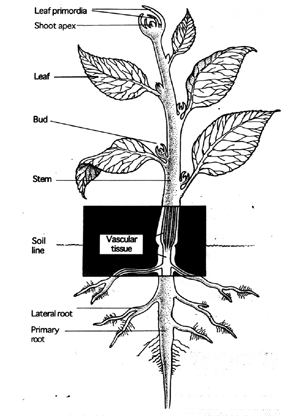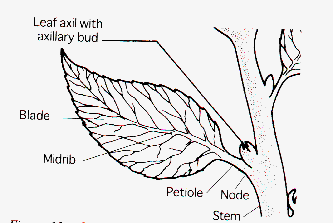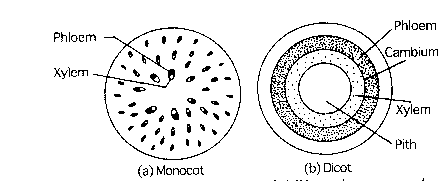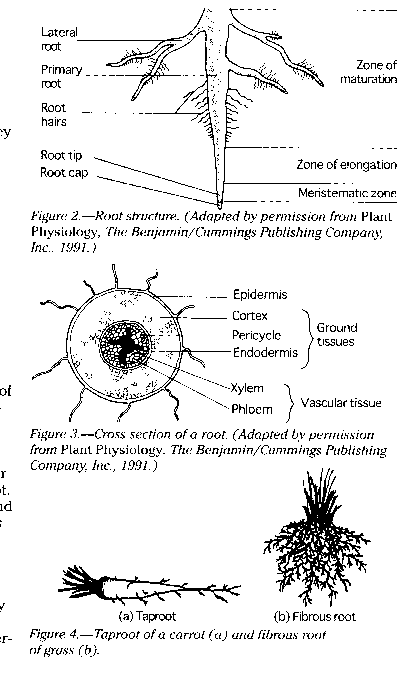Lesson Overview
This lesson is about the parts of a plant. It provides an overview of the four basic parts; leaves, stems, roots, and flowers. The functions of the basic parts will also be explored. The focus will be on vascular plants and includes an observation of your corn and bean growing now.
Goals for this lesson
- understand the basic parts of the plant from roots to leaves
- understand the function of each part.
Tasks
- read and study the information below
- complete and submit botany lesson 5 worksheet
Vocabulary
Assessment
- quality and completeness of assignment submitted
- identification of basic plant parts using living samples
- completion of activities
Reading
Most plants live in two different environments at the same time - air and soil. Leaves and stems are usually above ground, where they are surrounded by air and where light, carbon dioxide, and oxygen are available. Roots are in the soil, which supplies water and nutrients. Each part of the plant is adapted to its environment and for a specific function in the life of the entire plant.
Vascular plants contain water, nutrient, and food-conducting tissues called phloem and xylem. These tissues act like a system of pipes, circulating needed supplies to all the plant parts. All seed producing plants are vascular plants. Seed plants can be divided into two main groups of plants - angiosperms and gymnosperms. Angiosperms are flowering plants. They make up more than half of the different species of plants. Gymnosperms include a wide variety of shrubs and trees that produce naked or uncovered seeds. Angiosperms can be further subdivided into monocotyledons (monocots) and dicotyledons (dicots). The corn seed you are growing is a monocot and the bean seed is a dicot. You will see some important differences between the two types of plants as they begin to grow.
Most plants are made up of four basic parts: leaves, stems, roots, and flowers. Below is some general information about each part (except flowers). In later lessons we will look at flowers separately as well as explore the other parts in more detail.

Leaves
Leaves are the food factory of the plant. The principal function of leaves is to absorb sunlight to manufacture plant sugars through a process called photosynthesis. Leaf surfaces are flattened to present a large area for efficient light absorption. The leaf of a seed plant consists of an enlarged flat portion, the blade, connected to the plant stem by a petiole.
Leaves vary a great deal in shape and size. Most leaves are flat. Some, such as the leaves of pine trees are needlelike, while others, such as onion leaves, are cylindrical. The shape and sizes of leaves help us to identify plants.
The arrangement of leaves on plant stems is also used to identify plants. Some plants have leaves that alternate on the stem; some are positioned opposite one another. Others are whorled (arranged in a circle around the stem).
The blade may be in one piece or may be divided into separate leaflets (a compound leaf). Leaf blades have veins that form its structural framework. Leaf margins (edges of plant leaves) differ, ranging from smooth to deeply lobed or even jagged.

Stems
The plant stem connects the leaves and roots and supports the leaves and flowers in the light and air. They serve as conduits for carrying water, minerals, and food. The vascular system inside the stem forms a continuous pathway from the root, through the stem, and finally to the leaves. It is through this system that water and food products move.
Air enters stems through small openings on the stems surface called lenticels. Stems may be either herbaceous (green and relatively soft) or woody (brown and generally stiff). Although stems differ greatly in structure, all have buds.
A bud is a miniature shoot with a short stem, small immature leaves, and sometimes flowers. Buds on the bare twigs of deciduous trees are easily seen. Growth from a terminal (tip) bud lengthens the twig. Growth from a lateral (side) bud starts a new branch.
Some plants have stems modified for storage. White potatoes are underground stems modified for storage; their "eyes" are buds. An onion bulb is a small stem which lies underground and stores sugars in the form of starch.
The vascular system inside the stem consists of xylem, phloem, and vascular cambium tissue. It can be thought of as the plants plumbing. Xylem tubes conduct water and dissolved minerals from the roots throughout the plant. Phloem tubes transport food such as sugars from the leaves throughout the plant. The cambium is a special layer of tissue that separates the xylem and phloem and continuously produces new xylem and phloem cells.

Roots
Often roots are overlooked, probably because they are less visible than the rest of the plant. Roots function to:
- anchor the plant and hold it upright
- absorb water and minerals from the soil and conduct them to the stem
- store large quantities of plant food
- propagate or reproduce some plants
There are two types of root systems: fibrous roots and tap roots. A fibrous root system forms when many branching roots come from the bottom of the plant. Grasses, corn, beans, and clover have this type of root system. A tap root system is found in plants with a long, tapering root with slender, short side branches. Carrots are a good example of a plant with a taproot.
Root surfaces are covered with small structures called root hairs. Most of the water and mineral absorption occurs through root hairs. These root hairs penetrate the spaces between soil particles and absorb through their huge surface area the water and nutrients required by a plant.
